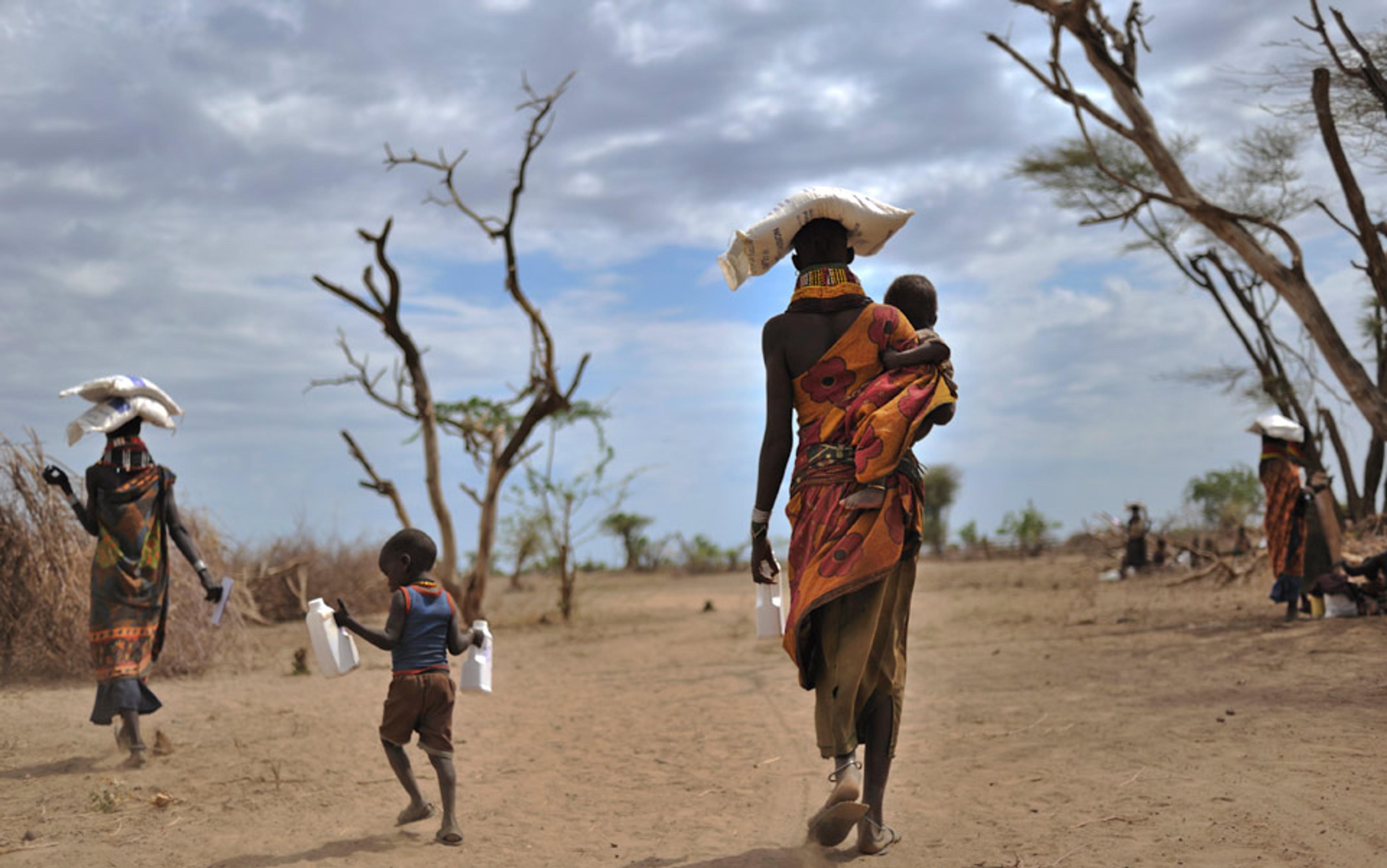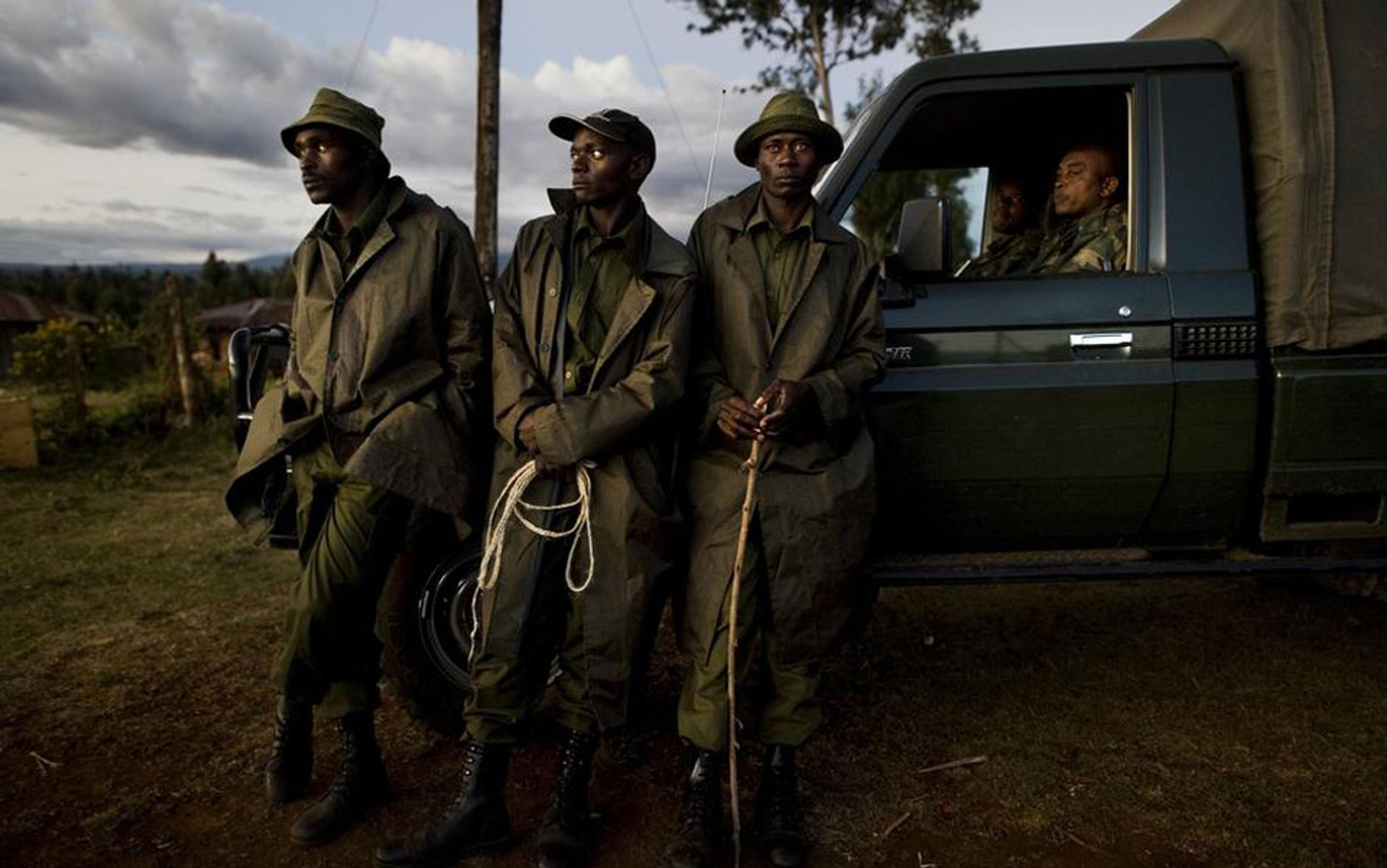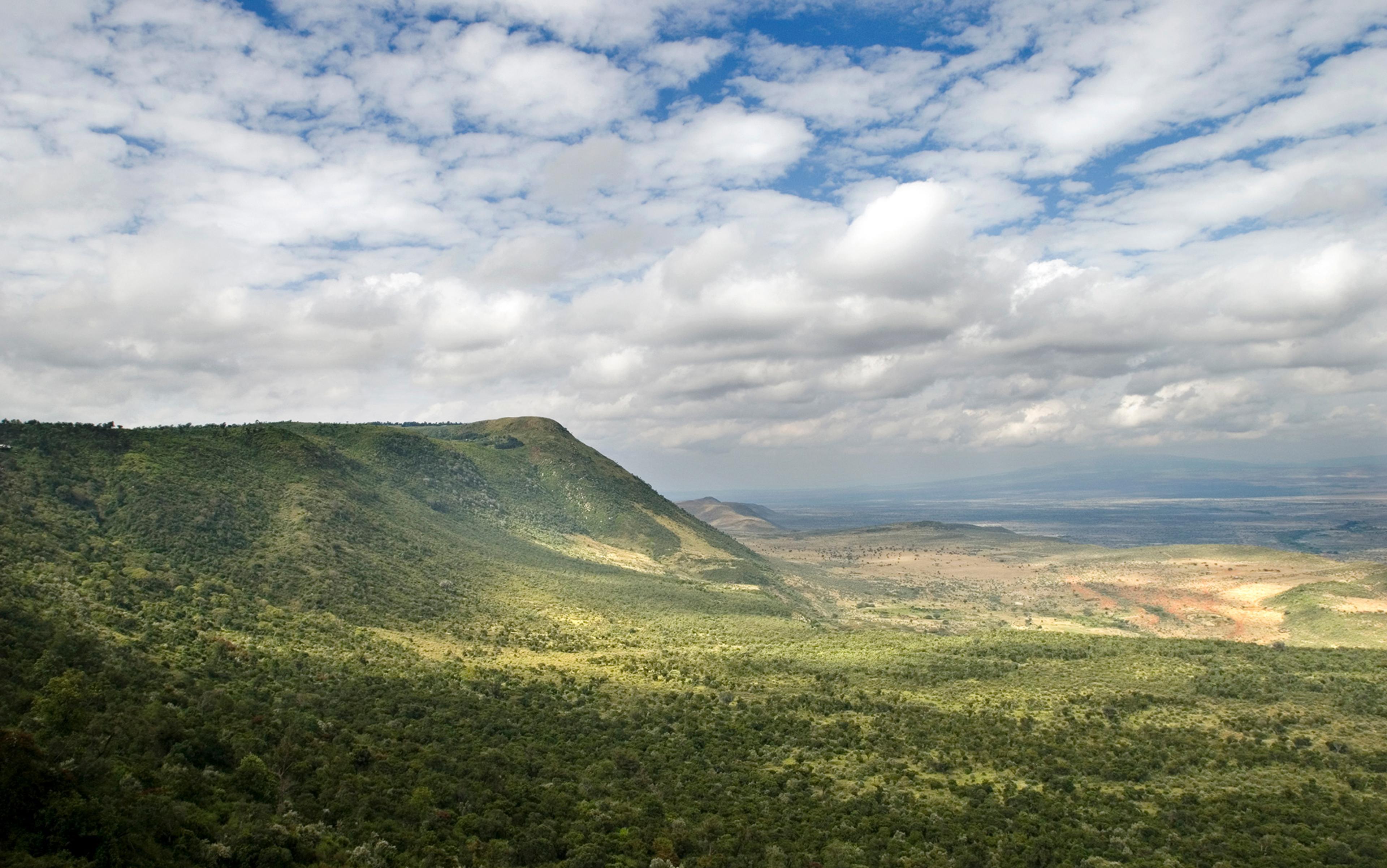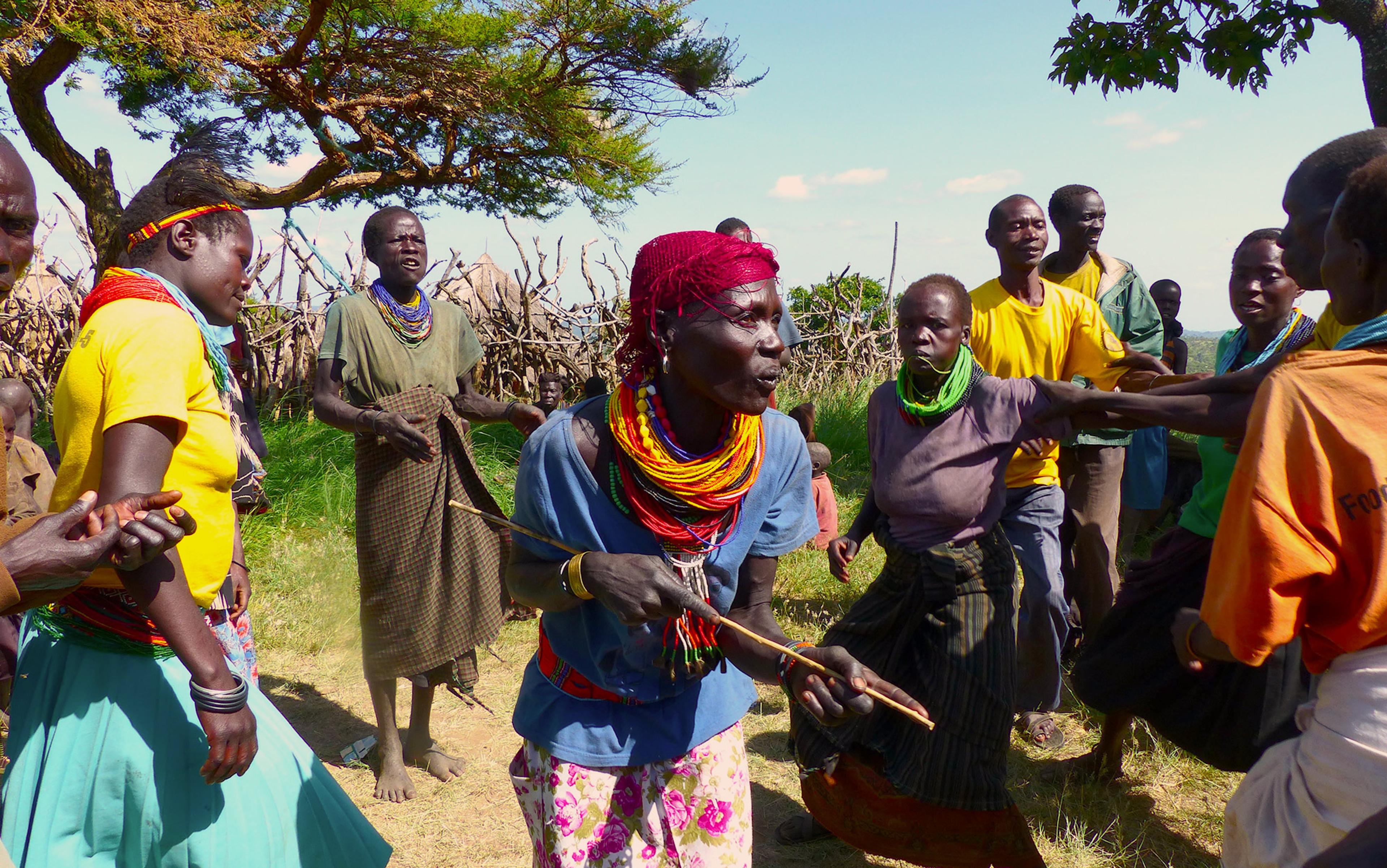A long way from anywhere, Lokichar is a one-street frontier town of dust-scarred butcher shops and general stores. The settlement straddles a single shattered highway that runs through Turkana, Kenya’s northernmost region, from the provincial capital of Lodwar, over a flat scrub of semi-desert split by dry river beds and twisted funnels of volcanic rock. The highway runs all the way to the giant camps at Lokichoggio, the refugee capital of East Africa.
Along the roadside, herds of cattle, goats, camels and donkeys pick through bare acacia trees, watched by Turkana pastoralists — tall, thin men in crimson blankets with shepherd’s crooks. Many have an AK-47 slung over one shoulder. Somewhere out in the dark hills, across the plain, is the loose and ill-defined border between the local Turkana and their neighbours, the Pokot. The two Nilotic cultures have been engaged for centuries in cattle raids that ebbed and flowed until a few years ago when a sudden influx of small arms across the porous borders with Uganda, Ethiopia and South Sudan allowed the conflict to escalate.
With the weapons, traditional conflicts over pasture and animals have become exponentially more violent. Rival tribes regularly raid deep into each others’ territory. In some places, cattle-rustling has become mechanised, with armed gangs crossing the borders and shipping herds on trucks either out of the country or down south, to Nairobi or Mombasa, for sale. When travelling in the region, international development agencies insist on armed guards.
‘This area is often a battlefield,’ said Benjamin Kakuta, a Turkana coordinator for an American development agency and an aspiring politician, as he looked warily across the sand.
Half an hour’s bone-jarring ride, over a road that the desert is fighting to reclaim, brings you to a wide square enclosure of barbed wire and guard towers surrounding olive-green barracks tents. Kakuta warned against slowing down near it. Security, he said, is tight. In Lokichar, a letter pinned to the doorframe of the Mashaallah café hinted at why. The notepaper was headed with the logo of Newport Africa, a company that specialises in providing ‘risk mitigation services’ for the oil industry. It listed the successful applicants for a training programme for security guards. Inside the complex, hidden behind the curve of the land, is the place where, in May 2012, explorers struck oil in Turkana.
Although the visible signs are still few, in less than a year Turkana County has gone from a scarcely mentioned backwater to the next big thing in the global energy industry.
‘Guys have been dying and starving,’ Kakuta said, ‘but they are sleeping on oil.’
Turkana is long overdue a change in fortunes. Lodwar, the administrative centre of the county, is composed of daub and concrete shacks, charity offices and a single, crumbling hospital barely worthy of the name. The dusty airstrip is decorated with an abandoned aircraft engine of unknown provenance. Nairobi is a long way away, and the Turkana refer to journeying out into their own country as ‘going to Kenya’.
There is a single crushed-earth road, where the white dust lifts up around the feet of the young men walking in close twos and threes. Open fires burn beneath stunted acacias or under the shadow of corrugated-iron awnings, and the smoke, rotten with rubber and plastic waste, leaches its way through the windless air.
The town has two guesthouses, one run by the Catholic Church, the other — the Lodwar Lodge — by a local MP. The Lodge is little more than a cluster of concrete cells open to the elements arranged around a dirt square, each named after an African capital. It’s attached to the one bar in town that shows English Premier League football, an obsession even here. In the evening, the dirt square behind it is packed with the local men, sitting around plastic tables eating goat meat and chapatti, and drinking beer served from a heavy metal cage. Almost to a man, they are employed by local NGOs as drivers or administrators, so this tiny island of prosperity is an illusion. Beyond the few heavy trucks that rattle through town, most of the vehicles wear the badges of international aid organisations.
The real commercial heart of the county is, for the time being, the central market. Livestock in Turkana is currency. From a young age, boys move the animals huge distances across the land from pasture to pasture. Dowries are paid in cattle, wealth is determined by the size of the herd. To sell for cash is an oddity tinged with shame, so even though the market starts to fill up just after dawn, the level of trade is tiny compared to the millions of goats and cattle scattered across the county. Trade is almost entirely local. Although traders from the south have visited, they do not routinely come here to buy — the goats are too small and too expensive.
At the end of the day, the last few traders from the market walk in limping convoy out of town, over the single-strand bridge and out into the wilderness that fades in colour with the evening light: sinewy silhouettes draped in their blankets, moving their goats with silent signals. They leave the town to the settled Turkana minority and to the sedentary shop-owners, many of them Muslims from Ethiopia or from Kenya’s northeast.
Now there is oil. And oil, as west Africa knows so well, changes everything
Pastoralism is a difficult existence, but in the past decade it has become even harder here. In Turkana, the battle with the weather has always been brutal, with what little rain there is driving the endless search for grazing land. Driving across the semi-desert, the sight of rank after rank of squat donkeys stretching to the horizon seems to show that the future might not be so bleak. But the last drought, more so than the one before, showed just how fragile the Turkana’s livelihoods are.
When the droughts hit, animals die by their thousands. The wealth stored in them is lost and cannot be recovered.
The 2011 drought was particularly devastating. It is hard to know how many people or animals died. Data collection in Turkana is made difficult by the terrain and the weakness of the statistical mechanisms in Kenya, but today, more than a quarter of a million people in the county survive on food aid. Nine out of 10 people live below the international poverty line of $1.25 per day. Another drought is forecast for 2013.
It is generally agreed, among the Turkana, the aid workers and the government, that these droughts have become more frequent and more severe. Flash floods caused by unpredictable rainfall across the border surge over the cracked landscape with greater violence, shredding infrastructure and overwhelming villages. The few forests left in the region are disappearing and being consumed by the desert. Across the country, similar patterns are emerging as, inexorably, East Africa heats up and dries out further.
Aid organisations are trying to encourage the Turkana to join the cash economy, selling their livestock ahead of droughts and buying more afterwards. Others push them towards sedentary lifestyles, encouraging them to hack irrigation channels out of the Lodwell River — a grey ooze that creeps slowly past Lodwar — to plant maize in rough lines on its banks. There have been some successes in creating small-scale projects, but they are hardly systemic in their reach, and it’s not clear that any are well-suited to this arid environment, with its already fluctuating rainfall and patchy plant growth.
Though they have been given new urgency since the 2011 drought, these are not new challenges — how, without destroying their traditions altogether, can the Turkana create sustainable livelihoods in the face of climate change? How can an economically, politically and geographically isolated population lift itself out of poverty with such scant resources? The economic landscape has taken an unexpected turn. Now there is oil. And oil, as west Africa knows so well, changes everything.
Just how much oil is underneath Turkana is not yet clear. Africa Oil Limited, a Canadian-listed company, made the first of the most recent plays in the region. ‘It’s a bit daunting,’ Keith Hill, the stocky American geologist who heads the company, told me as we sat in his glass-walled corner office at the new Nairobi headquarters in the well-heeled suburb of Westlands. ‘This tertiary rift basin [there] is pretty much the size of the North Sea, and there’s only three wells drilled. In the North Sea, there’s 2,400 exploration wells drilled. It really is early days in this play, but it took 58 wells to find the first commercial oil discovery in the North Sea. Here, we found it in the third well we drilled.’
A third-party reserve estimate by the petroleum consultancy Gaffney Cline and Associates puts the total prospect at 28 billion barrels in East Africa as a whole. Nigeria, sub-Saharan Africa’s biggest oil producer, has around 38 billion barrels in proven reserves. ‘This is huge,’ Hill said. ‘A billion here, a billion there; pretty soon, you’re talking real money.’
That there is ‘real money’ to be made in East African oil is not in doubt. The find in Turkana is just one of a pattern of discoveries across the region, starting in 2006 when Tullow Oil, now one of Africa Oil’s main partners in exploring northern Kenya, struck a commercial-scale deposit in the Lake Albert Rift in Uganda. That find has been mired in regulatory wrangling and is yet to see any production, but it revived interest in a region that had been off the radar for decades. ‘East Africa was a pariah,’ Hill told me. ‘If you talked about East Africa, you could barely get the meetings [with investors]. Now every conference I go to, East Africa is being talked about as the hottest exploration place in the world.’
The world consumes 85 million barrels of oil every day, and rising. As production in existing oil producing regions begins to plateau or decline, and the rate of new discoveries stagnates, the industry is going further into frontier markets in search of new reserves. The same necessity that has driven producers to sink wells ever deeper into the sea bed and tap the tar sands of Canada has pushed explorers across Africa.
Over the past two years, interest in East African hydrocarbons has accelerated along an onshore arc stretching from Uganda through Kenya, Ethiopia and Somalia. Offshore, there are huge gas deposits all along the East African coastline, especially near Tanzania and Mozambique. The Italian oil company ENI has talked of investing $50 billion in the region’s oil and gas. Other global players, including the China National Offshore Oil Corporation, have planted flags.
Ogoniland is on the other side of the continent, and Kenya is not Nigeria. But local and international observers have pointed to some alarming similarities
The potential benefits are clear. Countries that have historically lacked investment in infrastructure will see roads and pipelines built. Handled well, the capital investments and the revenues could be a shot in the arm for economies that are already on an upward curve, experiencing strong and sustained economic growth — albeit from a very low base — for the better part of a decade. However, with the hope that oil money will amplify East Africa’s business boom, come fears of the ‘resource curse’ — the corruption, environmental degradation and social disintegration that has often resulted from the exploitation of hydrocarbon reserves in the developing world. Few would begrudge Kenya an opportunity to escape the poverty and aid dependence that has dogged it since independence, but the risks of haste are huge.
The spectre of the Niger Delta, 3,000 miles west on the Atlantic coast, looms large. In exploiting this frontier region’s natural resources, Nigeria’s entrenched elites have fostered decades of criminality, corruption and violence. Institutionalised graft means oil revenues are squandered and misappropriated. Average citizens see little of the benefits of the industry.
In the Delta, local minority peoples, such as the Ogoni, were already discriminated against before oil raised the stakes. Leaders from the central government took advantage of the under-development and under-representation of locals to take their land. They passed land rights on to oil companies and maintained their own power through systems of patronage, with the right mix of ‘dash’ — bribes — creating a culture of dependency that remains almost impossible to break.
At the same time, Nigeria’s government escalated the repression of dissident locals, violently cracking down on nascent protest movements. The execution of the environmental and social activist Ken Saro-Wiwa in 1995 still stands as a testament to the inhumanity of Nigeria’s military administration. Saro-Wiwa and eight others killed at the same time — Saturday Dobee, Nordu Eawo, Daniel Gbooko, Paul Levera, Felix Nuate, Baribor Bera, Barinem Kiobel, and John Kpuine — were leaders of a non-violent protest group, the Movement for the Survival of the Ogoni People, campaigning for representation and the enforcement of environmental regulations in their region.
The oil industry’s big players have themselves paid a big price for the entrenched conflict and corruption of the Delta. In August 2012, Shell’s security bill in Nigeria was leaked to the pressure group Platform: in the course of three years, the company had paid $383 million to mitigate the risks of violence around its plants. Oil money has fuelled graft, kidnapping and militancy, and allowed companies to pay their way out of responsibility for environmental damage. Ultimately, it has led to the industry being widely seen as corrosive to the country’s future.
Ogoniland is on the other side of the continent, and Kenya is not Nigeria. But local and international observers have pointed to some alarming similarities.
Land and ethnic identity have often been at the centre of Kenya’s troubles. Politicians have fostered economic opportunities for their kinsmen. Some have even moved their people en masse onto better land, displacing indigenous people from the forests in the Mau or the fertile lands of the Central region, and creating generations of violent conflict. The pressure valve last blew in 2007, when accusations of vote-rigging in a general election exploded into ethnically charged violence. Neighbours killed neighbours. More than 1,000 people died and many more were displaced.
Institutionalised nepotism in central government has also contributed to a total neglect of Turkana county, both before and since independence. The Turkana are poorer, less healthy and have less access to education than their countrymen. The region feels viscerally like another country — another world — after the skyscrapers, expat bars and traffic jams of Nairobi.
‘The situation in northern Kenya is desperate,’ said Charles Abugre, a Ghanaian economist specialising in the management of natural resources, now based in Nairobi and studying the Turkana region. ‘It is historical. It is a very deliberately discriminated-against society.’
A new constitution, forged in 2010 during the introspection that followed the 2007 elections, should devolve more power to individual regions, including Turkana. It could address some of the imbalances, but it might be too late. According to Abugre, who also heads the UN’s Millennium Campaign in Africa, there has already been a land grab, referring to the sale of exploration and production rights by the government.
Community work in Turkana was coming too little, too late to forestall conflict
Traditional pastoralist cultures recognise collective rights over pasture — though there is often conflict over it — and signing away those rights is inevitably going to lead to battles. ‘If you don’t deal with the land problem,’ Abugre said, ‘it will be difficult to start talking about only oil. The oil is sitting on top of a time bomb.’
The stakes are high. A failure to meet local expectations of revenue from oil is likely to feed local resentment and violence, just as in the Niger Delta where kidnappings, thefts and ‘bunkering’ — the theft of oil from pipelines — are commonplace. One senior oil industry executive said that community work in Turkana was coming too little, too late to forestall conflict.
But many oil executives insist that their industry has changed. There is new legislation in some jurisdictions — such as the UK’s new Bribery Act 2010, which places legal obligations on companies to avoid graft overseas — and there are voluntary standards such as the Norway-based Extractive Industries Transparency Initiative. Spokespeople insist that helping to diversify local economies and being transparent about revenue streams will help to protect them. ‘If you build alternative economic centres, then these issues of security are likely to die away,’ said Martin Mbogo, Tullow Oil’s country manager in Kenya. ‘The more people that get engaged in productive sectors of the economy, the less likely that opportunistic crime will go on.’
As Africa Oil’s CEO Keith Hill said: ‘The real problem is going to be if people start thinking there are things happening under the table.’
Unfortunately, they already do. Kenya is already considered, internationally and locally, as hopelessly, endemically corrupt. On Transparency International’s corruption perception index for 2012 — which ranks Norway in first place and Afghanistan, Somalia and North Korea in joint last place — Kenya ranks 139th out of 176 countries. As one veteran UN staffer in Nairobi lamented, the country’s key sectors, from agriculture and power generation to forestry and fuel imports, have all been ‘divided up’ between the powerful vested interests always jostling to control the country. ‘Everyone’s just waiting to see who ends up owning the oil,’ he told me.
Oil production is several years away. It is a long road from discovering the reserves, to proving their viability and getting them out of the ground and into the international market. But investors and the media are already beginning to talk of the region as ‘oil-rich’. Watching Lodwar dissolve into dust and darkness as the night falls, the town lit only by open fires on the street and the occasional flickering headlight of a motorcycle taxi, it sounds ever so slightly like a cruel joke.






